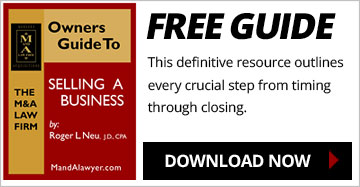Representations & Warranties in the Purchase & Sale of a Business

The Crocodile Hunter makes wrestling crocodiles appear easy compared to the tug-of-war that often ensues to determine which R&W’s the Buyer and Seller will give or receive.
BUT WAIT!
As the parties pull on opposite ends of the rope, sweat pours off their brows and the lawyers shovel advice as fast as they can to make sure their side will be the winner. The loser fears falling into the swamp where ferocious crocodiles must surely reside. The battle rages on…
There may be a better way. What if each of the parties and their attorneys discovered that the rope was attached to walls on both ends and that they would not fall into the “swamp” where crocodiles with gaping jaws are ready to devour them? Most Buyers and Sellers would probably stop pulling on the rope at that point. Many battles over R&W’s are waged because of misunderstandings regarding how R&W’s operate and the perceived protections or risks involved in giving or getting a particular R&W. This article addresses some of those misunderstandings in an effort to keep you out of a needless tug-of-war and to show you how to avoid the crocodiles in the swamp.
PURPOSE OF REPRESENTATIONS & WARRANTIES
The purpose of R&W’s is two-fold. First, they help the Buyer understand the business being purchased. Second, they establish liability of the Seller for losses arising during the Seller’s “watch” (prior to closing). One very common misconception is that there are fewer R&W’s in an “asset” purchase than in a “stock” purchase. In either case R&W’s will address 25 to 40 separate areas of the business with the exact number determined by the nature and type of business being acquired. All Buyers, whether purchasing assets or stock, want to understand what they are buying and do not want to assume unspecified or unknown liabilities or problems associated with Seller’s business. Sellers, on the other hand, want to make sure they are not increasing their liability by selling the business.
TYPICAL ORGANIZATIONS COVERED BY R&W’S
- Organization, Standing and Qualification
- Capital Structure
- Title to Shares/Units
- Authorities and Consents
- Subsidiaries
- Financial Statements
- Absence of Business Changes
- Absence of Undisclosed Liabilities
- Litigation
- No Breach or Violation
- Tax Returns and Audits
- Business Assets
- Real Property Leases
- Inventory
- Other Tangible Property
- Accounts Receivable
- Intellectual Property
- Company Name
- Title to Assets
- Customers
- Contracts
- Environmental
- Permits
- Insurance
- Employee Benefit Plans
- Employees
- Product Warranties
- Brokers
- Related Party Transactions
- Compliance with Laws
- Interest in Customers/Suppliers
- Books and Records
- Statement of Full Disclosure
USE OF R&W’S PRIOR TO & AFTER CLOSING
R&W’s point to two distinct time periods. The first time period is between the signing of the definitive agreement and the closing (the “Preclosing Period” ). During the Preclosing Period, if Buyer determines that there is a misrepresentation or breach of a warranty, Buyer will not be obligated to close the transaction. Actual termination of the transaction may be avoided, however, if the agreement provides that Seller is to be notified of any problems and that Seller has the right to cure those problems. The second distinct time period begins after the transaction closes. Now the R&W’s operate to provide remedies to Buyer in the event Buyer discovers a misrepresentation or breach of warranty after the closing. Those remedies generally involve a recovery of monetary damages and, in the most severe cases, could result in an action to rescind the transaction. In summary, R&W’s give the Buyer a possible out during the preclosing period and provide a means to recover damages after the closing.
WHO SHOULD MAKE THE R&W’S
Many arguments, delays and costs are a result of misunderstandings by attorneys and clients about how R&W’s and indemnities operate together in defining Seller liability. Limiting Seller’s liability in the indemnity section may overcome what may appear to be insurmountable issues in structuring the R&W’s. For example; a five percent shareholder (Seller) may have no problem giving R&W’s if his/her liability under the indemnity section is limited to five percent of the damage amount (often referred to as prorata/several recovery) and recovery is limited to actual proceeds received by the shareholder from the sale.
There are three main R&W flash points: (i) Who will make the R&W’s: (ii) Are R&W’s “joint and several:” and (iii) Are R&W’s absolute or based on “knowledge?” Buyers may want officers and directors to make R&W’s and assume liabilities. Nonowner officers and directors should not, however, be required to assume any liability in a transaction that does not provide them with any benefits. A common R&W misconception is that shareholders should not make R&W’s or have liability in the case of an asset sale. On its face, it would appear that company R&W’s in an asset sale would be adequate since the company is the Seller and receives the purchase price. Buyer, however, will ask for shareholders to make R&W’s because most companies will disburse the purchase price proceeds to their shareholders. Buyers want to make sure that they have the right to recover those proceeds from shareholders in the event of the company’s breach of the R&W’s.
ABSOLUTE OR BEST OF KNOWLEDGE R&W’S
Should R&W’s be absolute (“flat” or “bond” R&W’s) or based on the “knowledge” of the parties? A bond R&W is a guarantee and it does not matter that the party giving the R&W is unaware of any inaccuracy. If the R&W is qualified by “knowledge” then there is no breach if Seller had no “knowledge” of the facts giving rise to the breach. In most cases, some R&W’s will be bond R&W’s and some will have a “knowledge” qualifier. BUT, remember what I said earlier that R&W’s and the indemnities and remedies sections operate together to define Seller liability. Countless hours are spent on battles fought over whether R&W’s should be bond R&W’s or qualified based on “knowledge” and whether or not a breach would result in a “material adverse affect.”
The Seller may think he is getting a free pass if he can get “knowledge” qualifiers inserted in the R&W’s. Seller believes that if he/she has not seen or heard of any evil, then that “knowledge” qualifier in the R&W’s will eliminate any post-closing liability for damages arising out of events occurring during Seller’s watch (Preclosing). Even though Seller and Seller’s legal counsel win some of the battles to add “knowledge” qualifiers, they may be in for a rude surprise. Buyer may insist that Seller provide indemnification for all R&W’s without regard to the “knowledge” qualification or whether or not the breach results in a “material adverse affect.” For example, if Seller represents that “to the best of its knowledge all taxes have been paid and Buyer finds out after the closing that there are unpaid taxes, Seller will still be on the hook if indemnification applies without regard to “knowledge.” On the other hand, if Buyer finds out during the Preclosing Period that there are unpaid taxes, Buyer is still obligated to close the transaction if Seller did not have knowledge of that fact. Another very important point to understand is that the benefit of the “knowledge” qualifier in specific R&W’s may not be helpful if the financial statement R&W contains a bond warranty stating that there are no liabilities except those set forth in the financial statements, or if there is a stand alone R&W that simply provides that there are no undisclosed liabilities. All of the parties and their counsel need to be aware of both how the R&W’s interrelate and how the indemnities/remedies sections affect R&W’s.
JOINT & SEVERAL LIABILITY
Joint liability means that each party is liable for the full amount of any damages and several liability is prorata based on each party’s interest. Should R&W’s be “joint and several?” (Notice that I am referring to R&W’s and not “indemnities”). This issue gets far more attention than it deserves because the answer is; “it does not matter.” If five members of Seller represent that FACT A is true, there is no additional benefit to Buyer by adding that those same parties “jointly and severally” represent that FACT A is true. Adding “joint and several” terminology just increases sensitivities and causes more fruitless discussions and added costs for all parties involved. “Joint and several” terminology applies in the context of indemnity/liability, not in the context of R&W’s. Two or more parties making an R&W are, by definition, making it “jointly.”
DEFINING “KNOWLEDGE” & “MAKING FULL DISCLOSURE”
If there are “knowledge” qualifiers in R&W’s, the parties must clearly define what constitutes “knowledge.” Seller will want to limit “knowledge” to “actual knowledge without any actual investigation” while Buyer will want “knowledge” to include the obligation to make reasonable inquiries and investigations. Specific boundaries should be negotiated to determine the extent of any inquiries or investigation to be conducted. For example, Sellers may only be required to solicit the input of key officers or other specified management personnel.
One of the most important things a Seller can do is make full and complete disclosure of any exceptions to the R&W’s in the schedules that became a part of the definitive agreement. Buyers don’t like surprises. Issues disclosed prior to signing are far more easily resolved prior to signing than after closing. Sellers minimize post-closing liability by preparing good disclosure schedules. Since the disclosure schedules need to be completed prior to execution of the definitive agreement, it is important for Seller to complete the preparation of that material as soon as possible. Obtaining final disclosure schedules from the Seller is usually the pacing item that dictates when the definitive agreement can be signed.
CONCLUSION
R&W’s paint the picture of the business being acquired and provide protection for the parties. A clear and complete understanding of R&W’s can go a long way in both achieving client objectives and in avoiding unnecessary costs and delays in the negotiation process. It is also very important that the parties have a good working knowledge of the various aspects, nuances and inter-relationships of the R&W’s and indemnity provisions.
With experienced and knowledgeable legal counsel you can quickly, safely and efficiently navigate through the R&W’s and indemnity jungle. On the other hand, failing to understand this area of mergers and acquisitions can inflict serious injury on all parties involved. Tug-of-war should be a childhood memory and fighting crocodiles should be the sole domain of the Crocodile Hunter.
This brochure was prepared by the Law Offices of Roger L. Neu, Inc. Mr. Neu specializes in privately held company mergers and acquisitions. With over 20 years of experience, Mr. Neu has advised over 250 privately held businesses in various merger and acquisition transactions. Mr. Neu was a CPA with Price Waterhouse, later attended loyola Law School, graduating with honors, and worked with a large Orange County law firm for four years before establishing his law firm in 1982.
The materials in this brochure are excerpts from materials used by Mr. Neu in advising clients in merger and acquisition transactions. This brochure should not be relied upon as rendering legal advice.


